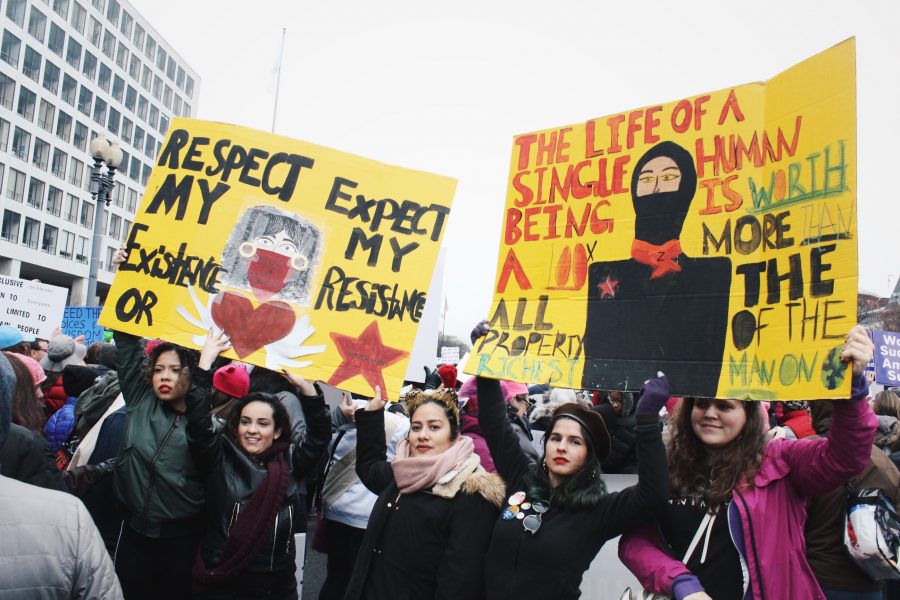Defiant voices take over Washington in Women’s March
January 23, 2017
On Saturday, Jan. 21, the largest protest in American history took place in Washington D.C and across the world. The Women’s March on Washington is estimated by organizers to have exceeded 500,000 in turnout, with many estimates ranging above one million. Over 2 million demonstrators participated in sister marches around the U.S. and worldwide. Millions of women, men, and children of radically different backgrounds united to voice their belief in women’s rights.
The huge crowds had one common cause: the universal belief that women deserve socio-economic equality and full control of choices made about their own bodies. Signs alluded to Trump’s crude remarks regarding his history of sexual assault. Protesters made it clear that they demand reproductive rights through the choice to have an abortion, and that women will relentlessly seek full social equality and take on leadership roles in society.
“The march really moved and inspired me because I saw how passionate and powerful women AND men were together,” senior and march attendee Diana Suk said. “When everyone was unified it taught me that the people of our country can come together and show how powerful and kind we are (when) united.”
The rally was a collection of many of the most prominent women’s rights activists, female politicians, and strong female leaders in the entertainment industry and pop culture. This included famed feminist Gloria Steinem, and many incumbent congresswomen as well as newly elected senators such as Kamala Harris (D- CA) and Tammy Duckworth (D- IL).
One of the musical highlights was the surprise performance by Alicia Keys, who empowered the crowd with a rendition of her hit “Girl on Fire.” To the crowds delight, Madonna appeared at the rally with a speech and a performance of her hit “Express yourself.” Performing artist and vocal feminist Janelle Monae also gave a performance with a call and answer song that fired up the audience.
Although the protest had a primary goal of rallying people to stand up for women’s rights and equality, many causes found a way into the huge crowd, due to the clear relation of the march to the inauguration of Donald Trump on Friday .
Posters regarding minority rights and anti-racial profiling signs made appearances. “Black lives matter” posters abounded, and an image of a woman in a red, white and blue hijab was widely used to represent support for Muslim communities. The march was a display of inter sectional feminism, with women of all races standing together in solidarity, and standing up for immigrants, the LGBT community, women of color, and Muslims alike.
“I think the march was really a statement about what so many Americans think the character of our nation should be,” said junior Sam Gollob, who attended the march with his twin sister. “It’s easy to hate, it’s easy to be exclusive, but it is hard to walk in someone else’s shoes and fight for what is right. I think that is why people are marching, to show the world that America is still brave enough to stand up to bigotry and hatred.”
Environmental justice was another recurring theme among protesters sentiments, with posters such as “Our planet can’t wait 4 more years” appearing in the wake of concern for Trump’s disregard to environmental conservation and the issue of climate change.
Many demonstrators sported pro- Clinton signs as they voiced their disillusion with the beginning of the term of a President who is seen as a threat to female empowerment and equal rights, as opposed to Friday being the inauguration of Clinton as the nation’s first female president.
The March represented a fundamental principle of our democracy; the American people are free to voice their beliefs as they choose, particularly in the form of nonviolent protest. With chants such as “This is what democracy looks like,” demonstrators made it clear that they want Donald Trump and his administration to hear their competing opinions. Crowd counting experts have estimated the march of Washington to have had 3 times the turnout of Trump’s inauguration, demonstrating the size and strength of the resistance movement.
Although the demonstration had clear anti-Trump undertones and the policies demanded line up in opposition to Trumps’s proposed plans, the now-sitting President tweeted on the right to peacefully demonstrate.
“Peaceful protests are a hallmark of our democracy,” President Trump said via twitter. “Even if I don’t always agree, I recognize the rights of people to express their views.”
With Republicans in control of Washington and clinching onto unchecked control of 30 state capitals, the future for women’s rights and other human rights causes may seem bleak due to the GOP’s general opposition to important women’s issues such as abortion rights.
However, the messages of hope and love provided by demonstrators and the efforts by speakers and march leaders to continue organizing and protesting after the march provide women’s rights activists with a clear platform and a bright future.
Demonstrators were encouraged by activists such as documentary filmmaker Michael Moore to continue their protest by calling their senators and assembling action teams to stand up for their beliefs.
“I think the people who went need to take action,” Suk said. “Especially the young people our age since we will have to deal with the next four years as young citizens, and we have a duty to act now!”
Although the march was a historic turnout for a pressing cause, and its importance to women’s rights activists should not be undersold, the important work is still ahead for activists as they saddle up for a new administration that is largely hostile to their beliefs.



